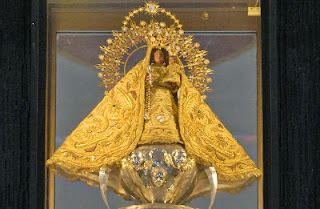Monday, September 8, 2014
The Virgin of Charity –Cuba’s Patron Saint
Every September 8th Cubans pay tribute to La Virgen de la Caridad or the Virgen of Charity of El Cobre, the most cherished religious image in Cuba.
Located in the town of El Cobre, few kilometers away from the eastern city of Santiago de Cuba, the Virgin’s sanctuary is visited by thousands of people from all over the world to pay promises and carry small copper rocks from a nearby mine, which, according to devout believers, give people good luck.
The legend has it that at the end of the 16th century three fishermen –Juan Esclavo, Juan Indio and Juan Pescador (John, the slave, John, the Indian, and John, the fisherman)- found the image of the virgin in the middle of a storm in the immense Nipe Bay in what is today known as the eastern province of Holguín. At the time of the finding, the piece of wood holding the image, which had a rare beauty and a copper-colored skin, read: “I AM THE VIRGIN OF CHARITY”. It is said that it appeared in the large bay to save the fishermen, symbolizing the birth of a people and a nation, made up of Spanish, African and Indian ancestors.
On September 24th, 1915, high ranking officers and members of the former Liberation or “Mambí” Army, who had fought on the island’s second independence war against Spain, asked Pope Benedict XV to proclaim the Virgin of Charity of “El Cobre” as Cuba’s Patron Saint. In a mass held the same day, the “mambises”, or former independence fighters, packed the old Sanctuary in the small town of El Cobre to request the canonical declaration from the Catholic Church. They also offered the Virgin a Cuban flag and promised to support the building of a new Sanctuary.
The canonical proclamation was approved by Papal decree on May 10th, 1916, less than a year after the Cuban patriots had requested it. The new Sanctuary opened on September 8th, 1927, 11 years after the proclamation. Years later, Pope Pious XI authorized the canonical coronation of the sacred image, but it was not until the morning of December 20, 1936 that the coronation ceremony was held and celebrated by Santiago de Cuba’s Bishop Monsignor Valentín Zubizarreta.
Much later, the Virgin of Charity of “El Cobre” –Cuba’s Patron Saint- was personally crowned by Pope John Paul II in a public mass at Santiago de Cuba’s Antonio Maceo Square during his historical visit to Cuba in 1998.
The Sanctuary of the Virgin of Charity of “El Cobre” is a neoclassical style construction built in 1927 on the summit of a hill on the island’s oldest copper mine which began to be exploited in the late 16th century. The current sanctuary, where mass is given every morning, has a silver altar and other highly valuable ornamental objects. Under the virgin, you can find the so called Chapel of Miracles, a small room where believers pay promises and deposit different offerings, including gold and precious stone jewels, clutches and other objects.
The Chapel of Miracles treasures the gold medal awarded to US writer Ernest Hemingway when he was proclaimed a Nobel Literature Prize laureate in 1954, donating it to the people of Cuba and offering it to the Virgin. The Virgin of Charity is also known as “Virgen Mambisa” or “Mambí” Virgin due to the devotion of fighters for the island’s independence wars against Spain, who were better known as “mambises”.
The Virgin is also worshipped by Afro-Cuban religious believers. In the Yoruba religion, the Virgin of Charity of “El Cobre” is known as “Ochún,” the deity of love and money and the owner of running water. Her festivities are linked to those of her sister “Yemayá” or “Yemanyá”, the Goddess of the Ocean, or the Virgin of Regla in the Catholic Pantheon, to whom believers pay tribute on September 7th.
The Virgin of Charity of “El Cobre” is part of the Cuban people’s spirit and culture and the virgin, the sanctuary and its surroundings have been declared by the Cuban National Heritage Commission as a Heritage of the Cuban nation. / With information from radio Havana Cuba
Subscribe to:
Post Comments (Atom)



No comments:
Post a Comment